About the National Football League
Updated: 2025
The National Football League is the largest professional American football league in the world. The modern NFL was created in 1970 by absorbing the American Football League’s ten teams. The merger created a unified pro football league, which has since become the most popular sport in America for nearly three decades in a row.
Though baseball is traditionally the sport associated with the United States, the numbers don’t lie. More Americans watch the NFL on TV than any other sport. More Americans attend football games than attend any other sport. And more Americans participate in fantasy sports versions of football, both pro and collegiate, than any other fantasy sport.
The National Football League is not just the most popular sports league in the country, it’s a huge industry. NFL team values have skyrocketed over the past couple of decades, to the point that the majority of the list of the most valuable sports teams is taken up by NFL franchises. The NFL is at the center of America’s massive entertainment industry, is the basis of an advertising juggernaut, and stands at the apex of professional American sport.
This page is designed to introduce you to the NFL. It covers its history, its traditions, its teams, and a whole lot more too. The following is a list of all the sections on this page, and you can simply click the relevant button if you want to jump straight to a section that interests you.
NFL History
The game of football owes an obvious debt to rugby. Before football was formalized in 1876, rugby was by far the most popular sport at the collegiate level in America. By 1896, the sport was so popular at colleges, some players were being paid hundreds of dollars in exchange for playing for a university. But the game played in the late 19th century doesn’t resemble the modern game of NFL football much at all. For starters, field goals were worth five points and touchdowns were worth just four. Another big difference – a final score of 5-0 or 5-4 was common, as was a tie of 0-0.
The Earliest Days of the NFL
In 1902, the first league calling itself the NFL was formed. This National Football League had just three franchise members: a group of amateur mine workers calling themselves Kaneweola AC, the Philadelphia Athletics (pro baseball players looking to make extra money during the off-season), and the Pittsburgh Stars. This league lasted exactly one three-game season, and at season’s end, all three teams tried to claim the national title.
The forward pass wasn’t officially legalized until four years after the first National Football League’s collapse. In 1906, semi-pro leagues across the country embraced the change, and immediately other rules were affected. Field goal values dropped, first to four points, and eventually to three. Touchdown values increased from four points to five, and eventually six.
1906 was also the year of the first major betting scandal in pro football history – a minor league in Ohio was found to be complicity in organized crime activity. The scandal caused a temporary collapse in the popularity of the sport.
By 1920, American professional football was in a state of chaos. Salaries had risen dramatically, to the point that small markets couldn’t compete for the better players. Without regulations governing trades and player movement, it was impossible for a team to build a stable lineup. Different rules between different leagues was seen as the major reason for lack of fan interest. Because of all these problems, a group of Ohio pro teams (among them, not a single team currently still playing football) decided that one large league with standardized rules would be more appealing to audiences. This was the birth of the American Professional Football Conference, the first major pro league in history.
The AFPC quickly morphed into the AFPA, a league with a 22 team membership. The Green Bay Packers were early signees to the new league, run by John Clair of the Acme Packing Company. Another team in this proto-NFL was the Decatur Staleys, who would soon move to Chicago and become the Chicago Bears. In 1922, the American Professional Football Association changed its name to the National Football League.
The NFL: A Growing Professional League
The next four decades were a time of the refining of rules, scheduling issues, financial regulations, and roster sizes. The modern game of football owes a great debt to the rule changes that took place in these early days of the NFL, before the merger of 1970 created the modern league as we know it.
The merger came about because of competition between the American Football League and the NFL. The AFL was founded in 1960 by people who’d been denied expansion franchises or were frustrated by the restrictions placed on them as minor shareholders in large NFL franchises. No one in the NFL was worried about the AFL until that league signed 75% of the NFL’s first round draft picks in its first year. The AFL premiered with eight teams.
- New York Titans
- Boston Patriots
- Buffalo Bills
- Houston Oilers
- Los Angeles Chargers
- Denver Broncos
- Oakland Raiders
- Dallas Texans
All of these would appear in one form or another in the NFL, and all are still playing in the post-merger league. Though the AFL struggled to keep up with the NFL’s popularity in general, its television contract with ABC (and later NBC) kept the league afloat. Since the AFL was more offense-minded, with rules that slightly favored offenses over defenses, it was the first hugely-popular TV sports league.
The 1970 AFL-NFL Merger
With rising costs affecting both leagues, and too many examples of player sniping ruining schedules and team strategy, the leagues agreed to a partial merger in 1966. This was a hybrid league – the two leagues only competed once per year, in the league championship game. The only other connection was a common draft, designed to condense the talent pool and create more parity in both leagues. But this hybridization incorporated planned obsolescence – one of the stipulations was that both leagues would be fully-merged by 1970.
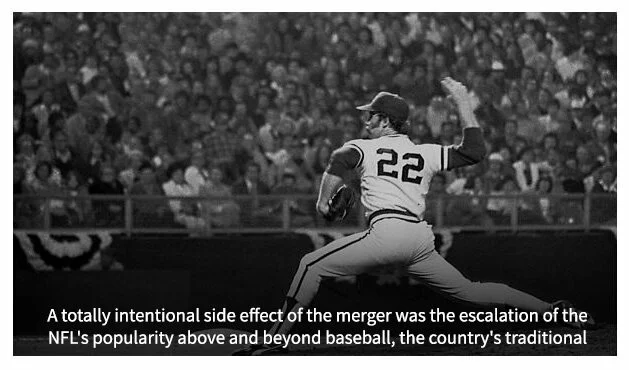
The new NFL had a team within an hours’ drive of each of the country’s top-40 metro areas, and the new more powerful league was able to execute contracts to have their games shown on each of the big three TV networks. Both sides of the merger could claim a victory. The AFL gained legitimacy by becoming the AFC and joining the NFL – the NFL gained popularity by incorporating some of the new offensive rules in place in the AFL and by swelling to 26 teams overnight.
The decade immediately following the merger was another time of growth for the league. Hash marks were moved for the first time in forty years. Ties were incorporated into the scoring system. Teams moved, built stadiums, and then moved again. 1973 brought us the first telecast of the Super Bowl, a tradition that now stands in for football as a whole. That same year, the jersey numbering system was standardized, so that it’s easy to tell what position a player holds by the number on their jersey.
Football Comes Into Its Own
Much of the success of the modern NFL is laid at the feet of former league Commissioner Pete Rozelle. Rozelle led the league from 1960 to 1989, overseeing the merger with the AFL, the expansion to 32 teams, and some major rule and culture changes in the league. During his tenure, average attendance increased six-fold, from just under three million a year in 1960 to just over eighteen million a year by 1989. Though the Super Bowl wasn’t televised until Rozelle’s thirteenth year in office, by the end of his time as commissioner, 400 million people were watching the game each year.
Increases in league parity, changes to television contracts, a solid collective bargaining agreement, and a number of disciplinary changes are due to the influence of Paul Tagliabue throughout the 80s and 90s. In fact, you could say that the recent history of the NFL is more of a history of the league’s commissioners.
NFL Commissioners
The role of the NFL commissioner is an important one. It’s one of three defined officer positions in the National Football League, with the other two being the secretary and the treasurer. Both of those two positions are appointed by the commissioner, who has several other responsibilities too.
The NFL commissioner handles disputes between clubs, players, coaches and other employees. He is also responsible for the recruitment of league employees and the negotiation of media contracts. He has the power to discipline NFL teams, and the owners of teams, should they breach the laws of the league or behave in a manner that is considered to be to the detriment of the league. This power can extend to handing out fines, suspensions, and a variety of other punishments.
Below is some information on each of the men who have held the role of NFL commissioner.
Elmer Layden (1941 – 1946)
Elmer Layden was the first man who could truly call himself a football commissioner, though he served three decades before the merger into the modern NFL. Elmer Layden was elected by the franchise owners of teams in the National Football League to do for football what Commissioner of Baseball Kenesaw Mountain Landis was doing for baseball. Layden is best remembered as a member of the Four Horseman and coach of the 1938 National Champion Notre Dame football team. His time as NFL commissioner is mostly forgotten because it was uneventful. He was replaced for being too much of a gentleman.
Bert Bell (1946-1959)
Bert Bell had a long tenure but was victim to most of the same complaints lobbied against Elmer Layden. He coined the phrase “On any given Sunday, any team can beat any other team.” He dealt with a couple of small-scale betting scandals, avoiding public scrutiny. Bell’s biggest impact on the modern NFL was the invention of revenue-sharing, which allows small-market teams to compete with teams from big cities. That system is still in use today. Bert Bell died in the stands at a game between the Eagles and the Steelers, at the exact moment Philadelphia scored a game-winning touchdown.
Pete Rozelle (1960-1989)
Pete Rozelle’s election to the role of NFL commissioner was seen as a compromise between feuding franchise owners. Rozelle was the GM of the then-Los Angeles Rams at the time of the election, and his name didn’t even appear on the first five ballots. Though he was a dark horse candidate, he was clearly the man for the job. Pete Rozelle’s impact on the modern game can’t be understated. At the beginning of his tenure, the NFL was a twelve-team league playing twelve games a year to tiny stadiums half-filled with bored fans. By the late 1980s, his league will have more than doubled in size, taken over the role of “national pastime” from baseball, and produced billions of dollars in revenue thanks to exclusive broadcast deals with major television networks. The 1970 merger took place under Rozelle’s watch. The rules changed so many times, it’s difficult to remember what the game was like before 1960. Rozelle’s retirement in 1989 was bittersweet; it was also the last time that NFL owners would in large part be on friendly terms with the commissioner.
Paul Tagliabue (1989-2006)
Paul Tagliabue’s tenure as commissioner gets a bad rap. Yes, growing revenue disparity concentrated high-quality players in a small number of teams. Yes, Tagliabue and the league ignored warning signs about concussions and performance-enhancing drug abuse. Yes, Tagliabue oversaw the league during a veritable plague of player crimes, mainly domestic abuse and other violent offenses. But as a manager, Paul Tagliabue (the league’s former lead attorney) presided over nearly two decades with no labor disputes or lockouts, and he oversaw the expansion of the NFL into six new markets. Tagliabue managed to maintain a friendly relationship with player representatives and the player’s union, while at least paying lip service to cleaning up the game’s image, with ever-increasing penalties for excessive celebration.
Roger Goodell (2006 – present)
Goodell was the obvious choice for commissioner to replace Tagliabue. He was Tagliabue’s next-in-line, his right-hand man, his student. Goodell’s appointment was met with little surprise or enthusiasm. Agree or disagree with Goodell’s policies, you have to admit that he’s made a lot of noise in the past decade:
- Increased the sport’s profile in foreign markets, particularly England
- The “Personal Conduct Policy”
- A quick and thoughtful response to Spygate (and a less-thoughtful and maybe too quick response to Deflategate)
- Reaching a nearly-$1 billion settlement with former players over brain damage
- Discussions of expansion with Las Vegas, Mexico City, other new markets
NFL Player Positions
In American professional football, each team fields eleven players. Every player has a designated position that outlines his specific role in the game.
Below is a guide to every position that players fill in the modern NFL. We organized the positions by three broad categories: offense, defense, and special teams. We did that to mirror the way teams have traditionally organized their players.
Positions on Offense
Quarterback (QB)
Numbers: 1-19
The quarterback takes the football from the center to start each play. Usually, the QB takes the responsibility for play-calling in certain game situations, and at very least is the player who takes the signal from the sideline and communicates the play to the offense. Once the ball has been “snapped” (passed from the center to the QB), the quarterback can make one of three choices.
- He can run the ball
- He can choose to hand the ball to any eligible player
- He can thhow a forward pass to a reciever further down the field
Quarterbacks are some of the best-known and highest-profile players in the league. The best quarterbacks command high salaries and make fortunes in endorsement deals.
Famous quarterbacks include Johnny Unitas, Joe Montana, and Brett Favre.
Running Back (RB/FB)
Numbers: 20-49
Running backs line up behind the offensive line and stand near enough to the quarterback to accept the ball and make a run for it. Teams can use anywhere from zero to three running backs in a play. Traditionally, running backs are broken up into two categories – standard running backs, who tend to be quick but strong with good hands for receiving, and fullbacks, who often serve as blockers and guards and tend to be stronger and not as fast.
Famous running backs include Jim Brown, Emmet Smith, and LaDainian Thomlinson.
Wide Receiver (WR)
Numbers: 10-19 / 80-89
Wide receivers specialize in catching passes. Sometimes, wide receivers are called on to block, especially on run plays. Generally, receivers line up in two split groups on either sideline at the start of each play. Receivers can line up in any position behind the line of scrimmage. The ideal wide receiver body is lithe and quick – they are often the lightest and fastest players on the offense.
Famous wide receivers include Don Hutson, Jerry Rice, and Randy Moss.
Tight End (TE)
Numbers: 40-49 / 80-89
The tight end position is a hybrid of lineman, receiver, and running back. Teams can have anywhere from zero to two TEs on any play. They tend to lineup on either end of the line, next to the OTs. Tight ends are usually called on to block more than to catch a pass or run the ball. They are, however, eligible receivers, and many NFL teams have taken advantage of that fact, packing the ends of the line with big guys that can catch the ball in tough spots. The ideal body type for the modern tight end is big, tall, and quick.
Famous tight ends include John Mackey, Shannon Sharpe, and Tony Gonzalez.
Center (C)
Numbers: 50-79
The center starts the play from the line of scrimmage by snapping the ball, usually to the quarterback. Taking up the middle of the offensive line, the center is often the shortest, heaviest, and strongest player on the offense. Like the other offensive linemen, centers are responsible for both blocking the defensive line and creating holes. The center tends to be the leader of the O-line, calling out changes to blocking and other adjustments.
Famous centers include Jim Ringo, Jim Otto, and Mike Webster.
Offensive Guard (LG/RG)
Numbers: 50-79
Two guards line up on either side of the center on every down. They are traditionally referred to as the left and right guards, though most players can perform from either position. The job of these interior linemen is to block, regardless of whether the play is on the ground or in the air. Guards sometimes also “pull” to create holes for runners to move through. The ideal body type to play guard would be shorter, stockier, and more athletic than an offensive tackle, but still taller than the center. This is a surprisingly under-appreciated position, since they’re usually called for false start and holding, and don’t get a chance to put up numbers. Still, a good pair of guards can turn a good running game into a legendary one.
Famous guards include Gene Upshaw, Randall McDaniel, and Larry Allen.
Offensive Tackle (LT/RT)
Numbers: 50-79
The two linemen who play outside of each guard are called offensive tackles. The OT on the left is the left tackle; the OT on the right is the right tackle. They mainly block, though occasionally they’re called on to create motion or a hole for a runner. Since most of the best QBs in the league are right-handed, the left tackle is a pivotal role on the line. This player has to protect his quarterback from being hit on his blind side. In fact, the left tackle is usually the smartest and most talented player on the line. The ideal body size for an offensive tackle is massive and inhumanly tall – the bigger and taller, the better.
Famous offensive tackles include Forrest Gregg, John Hannah, and Anthony Munoz.
Positions on Defense
Defensive Tackle (DT)
Numbers: 50-79 / 90-99
Think of DTs as defensive guards – they play at the center of the D-line generally opposite of the offensive line’s guards. Their goal, and only goal, is to rush to whomever is holding the football and tackle them. This is usually the passer, but can also be a running back or receiver behind the line of scrimmage. DTs are the giants of the defensive line – the ideal body size for defensive tackles is 6’6” and 300+ pounds. But they also need excellent hands and as much agility as is possible.
Famous defensive tackles include Joe Greene, Reggie White, and Bruce Smith.
Defensive End (LE/RE)
Numbers: 50-79 / 90-99
Each defensive line has two defensive ends that line up next to the DTs. These players control the ends of the D-line. Their first goal is to attack the passer, their second goal is to disrupt the pass, and as a final goal, they may attempt to stop a run play. Traditionally, modern defensive ends are positioned based on speed. The faster DE lines up on the right side of the line – the QB’s left side – in order to take advantage of the blind side. The player most interchangeable with defensive ends are linebackers – in fact, they generally have the same body type. Both DEs and LBs should be tall, and while modern LBs tend to be lighter and faster, they come in all shapes and sizes depending on the needs of the defense.
Famous defensive ends include Gino Marchetti, Reggie White, and Julius Peppers.
Linebacker (MLB/OLB)
Numbers: 40-59 / 90-99
Linebackers are the headhunters of the defense. They usually line up behind the defensive line. Their duties depend on the style of the team’s defense, the game situation, and their abilities. Modern linebackers are generally broken up into two categories – middle linebackers, who line up in line with the center of the D-line, and outside linebackers, who flank the MLB position. Linebackers are responsible for putting pressure on the QB, while covering receivers and providing a general defensive net against run plays.
Famous linebackers include Dick Butkus, Lawrence Taylor, and Ray Lewis.
Cornerback (CB)
Numbers: 20-49 (can wear 1-9 during preseason only)
One of two positions considered “defensive backs,” cornerbacks are typically two players whose only job is to cover wide receivers. Cornerbacks are quick and dirty pass disruptors, skilled at swatting and confusing the direction of airborne balls. Cornerbacks are generally more likely to catch interceptions based on their skill set and position on the field. Cornerbacks are always shorter, lighter, and have better hand skills than safeties.
Famous cornerbacks include Dick “Night Train” Lane, Rod Woodson, and Darelle Revis.
Safety (S)
Numbers: 20-49 (can wear 1-9 during preseason only)
Taller, heavier, and less athletic than cornerbacks, safeties are defensive backs who line up the farthest from the line of scrimmage of any player on the field. They play an assistant role for cornerbacks, providing deep-pass coverage and a last line of defense in case of a breakout run play. Safeties in the modern game are broken up into two categories – the strong safety (SS) and the free safety (FS). Strong safeties are the biggest and strongest defensive backs, while free safeties are small and quick, playing deep in the field and only getting involved in the case of a long bomb.
Famous safeties include Yale Lary, Ronnie Lott, and Ed Reed.
Positions on Special Teams
Kicker (K/P)
Numbers: 1-19
The kicker is responsible for kicking extra points, field goals, and kickoffs. Some teams have a specialized kicker for punts and one for shorter-field kicks or PATs. Kickers are usually small, no heavier than 190 pounds or so and no taller than six feet. They’re often trained in soccer and rarely perform any other role on the team.
Famous kickers include Lou Groza, Reggie Roby, and Adam Vinatieri.
Long-Snapper (LS)
Numbers: Any
Long-snappers are specialized players that fulfill an unofficial role. Long-snappers need the particular ability to snap the ball very long distances with pinpoint accuracy. Generally, centers with this special talent fulfill this role, though not every long-snapper in the business has been an offensive lineman.
Famous long-snappers include Justin Snow, Ethan Albright, and Jay Alford.
Returner (PR/KR)
Numbers: Any
A punt- or kick-returner is usually a wide receiver, defensive back, or running back, though technically any position can play this part. The returner is positioned to catch punts or kicks and is usually the fastest and most agile player available. The returner’s profile has increased in the modern NFL – more and more returns for TDs are being recorded each year as this specialist role is perfected. The ideal punt- or kick-returner is tall and lithe with great hands.
Famous returners include Herschel Walker, Deion Sanders, and Devin Hester.
Modern Game Rules
American-style football has evolved over the past 125 years, from a variant of rugby and soccer to a unique game with a massive global following and billions in total revenue. Let’s take a look at how some major rules of the game have changed since its invention.
Roughing the Passer
This rule prohibits making contact with the passer after he’s completed the pass. The rule wasn’t added until 1938, when the act of hitting the passer once the ball left his hand was labeled “unnecessary roughness.” This rule change codified a tradition whereby referees called a foul if the QB was hit, unless he was obviously still in play. This rule change, combined with the rule allowing forward passes in the 1920s, led directly to the creation of the QB-dominant league we see today.
The Use of Helmets
Helmets were not required equipment for football players until 1943. This sounds crazy to fans of the modern game, especially considering the debate raging today over concussions and the dangers of football. What led to the requirement for helmets? Massive numbers of players dying from injuries received during play. By 1943, an average of twenty people per year were killed due to injuries sustained while not wearing a helmet.
Dead Ball and Face Mask Rules
These days, the ball is considered dead if the runner touches the ground with any part of the body except his hands or feet “while in the grasp of an opponent.” This hasn’t always been the case. In the days before the rule change in 1955, runners were sometimes called down for touching the ground with their hands. Other leagues didn’t call a runner down until he was flat on his back. Why was the rule changed? Teams in the 50s were mainly concerned with low audience turnout. By codifying a number of rules and creating a standard, the game was easier to follow.
A year later, a rule against “grasping the face mask of any opponent except a runner” was standardized, and a penalty of five yards established for breaking the rule. Within five years, the problem of head trauma after face mask content had gotten so serious, the penalty was increased to 15 yards with the possibility of a flagrant foul and ejection.
Blocks Below the Waist
In 1974, a series of rule changes were implemented to further protect players. The main rule added to league play went as follows.
“Eligible receivers who take a position more than two yards from the tackle, whether on or behind the line, may not be blocked below the waist at or behind the line of scrimmage.”
The rule clarifies further that no receiver, eligible or not, can be blocked below the waist past the line of scrimmage. Blocks below the waist were sometimes called “crackback blocks,” and the 1974 rule changes were designed to regulate them. For example, one of the rules added prevented contact below the waist against blockers moving toward the ball. These illegal blocks were seen as so dangerous, the league implemented a 15-yard penalty and potential ejection for each offense.
Unnecessary Roughness
Though a penalty for “unnecessary roughness” had been part of the league since its earliest days, the penalty had never been codified until a group of players in 1979 threatened to strike unless certain demands were met. One was a demand for the addition of several hits under the unnecessary roughness umbrella:
- Non-contact acts like throwing a punch or arm or kicking or pushing an opponent outside of play. This rule was later amended as an additional “unsportsmanlike conduct” penalty.
- The use of a helmet to “butt, spear, or ram an opponent.” This rule also prevented the use of the “crown or top of the helmet” unnecessarily.
- A chop hit by a player in the backfield, especially when used on an outside rusher on a pass play.
Horse-Collar Tackles
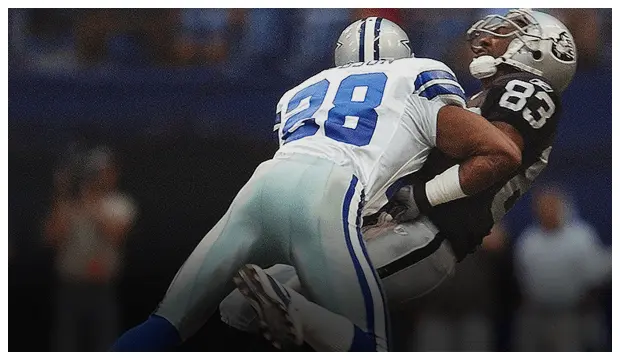
For decades, players had used the back of a player’s padding for assistance in tackling. A horse-collar tackle was one where the defender would grab the back collar of an opponent’s shoulder pads and pull them directly downward, sweeping the player’s feet out from under them. Tackles of this nature can lead to serious injury in several parts of the body.
Pro Bowl safety Roy Williams was the best-known practitioner of the horse-collar tackle.
Banned in 2005, the tackle has fallen out of fashion to the point that most teams won’t see a single call all season.
NFL Team Guide
Here’s a guide to each of the NFL’s thirty-two teams. We’ve broken our guide up into conferences and divisions, because that seemed like the most logical way to organize the list.
American Football Conference
The AFC was created after the merger of the American Football League with the National Football League in 1970. The modern AFC has been dominated by just a few teams – only six teams have represented the AFC in the Super Bowl since the year 2000. By contrast, the NFC has sent eleven teams for the same job. Here’s a look at each team in the AFC, broken up by division.
AFC East
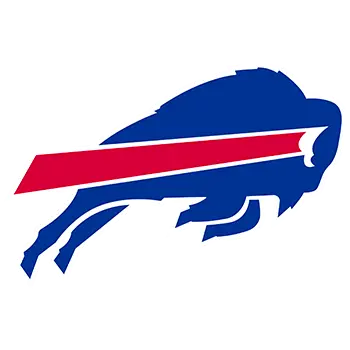
NFL Championships: 0 wins out of 4 appearances
All-time W-L: 438-486-8 (47%)
The Buffalo Bills play at Ralph Wilson Stadium in Orchard Park, New York. The Bills are an original franchise of the American Football League, competing in every NFL season since the 1970 merger. Though the team won back-to-back AFL championships in ’64 and ’65, the team has yet to claim an NFL title, coming up short four years in a row in the early 90s. That Bills team regularly stumbled against a juggernaut Dallas Cowboys dynasty which would go on to win three Super Bowl titles.
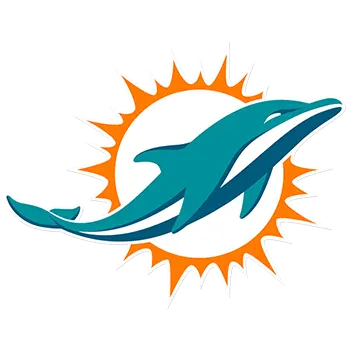
NFL Championships: 2 wins out of 5 appearances
All-time W-L: 467-377-4 (55%)
The Miami Dolphins play at Sun Life Stadium in Miami Gardens, Florida. The Dolphins are the oldest NFL franchise in the American South, having joined the American Football League in 1966. The 1972 Dolphins are the only NFL team to finish an entire season undefeated. Among the winningest franchises in modern sports, the Dolphins are in the middle of a major playoff drought. The team has reached the postseason just once in the past fifteen years.
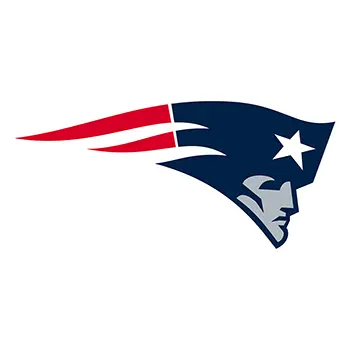
NFL Championships: 6 wins out of 11 appearances
All-time W-L: 519-404-9 (56%)
The New England Patriots play at Gillette Stadium in Foxborough, Massachusetts. Since the arrival of head coach Bill Belichick in the year 2000, the Patriots have become one of the most successful teams in the NFL, missing the postseason just three times in twenty seasons. Belichick and his former star QB Tom Brady have won six Super Bowl titles together, while winning 73.6% of the time. Before the Belichick era, the Patriots were historic also-rans. But there’s been a dark side to Belichick’s leadership – the Patriots were caught spying on opposing teams at least twice during Coach Belichick’s reign, and Tom Brady was at one time suspended for an entire season for his role in a deflated football fiasco.
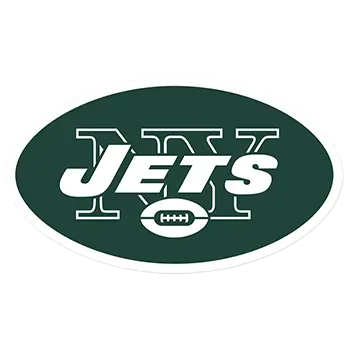
NFL Championships: 0 wins out of 0 appearances
All-time W-L: 410-510-8 (44%)
The New York Jets play at MetLife Stadium in East Rutherford, New Jersey. The Jets were an original member of the American Football League, winning Super Bowl III against the Baltimore Colts. Though the Jets are one of the more storied franchises in the league, they’ve had little postseason success. The team hasn’t appeared in a Super Bowl since 1968. The rivalry between the Jets and the New England Patriots is one of the liveliest in all of sports.
AFC North
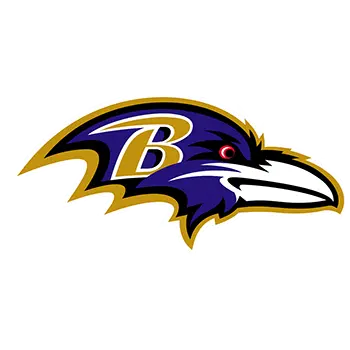
NFL Championships: 2 wins out of 2 appearances
All-time W-L: 225-174-1 (56%)
The Baltimore Ravens play at M&T Bank Stadium in Baltimore, Maryland. The Ravens are the epitome of a successful expansion team, having joined the league in 1999 as part of a deal the NFL made to keep the Browns in Cleveland. During their two-decade run, the Ravens have racked up two Super Bowl titles, two conference championships, and a reputation for brutal defense. The Ravens are the 24th most valuable sports franchise in the world, one of the NFL’s few billion-dollar value teams.

NFL Championships: 0 wins out of 2 appearances
All-time W-L: 363-452-5 (45%)
The Cincinnati Bengals play at Paul Brown Stadium in Cincinnati, Ohio. The Bengals heyday was the 1980s, when the team appeared in the only two Super Bowl games in franchise history. Both times, the Bengals were defeated by a tough 49ers squad. Cincinnati is experiencing a new flash of football success, having appeared in the playoffs four seasons in a row. Young phenom QB Andy Dalton has played a major part in the revitalization of the program but the success has faded in recent years.
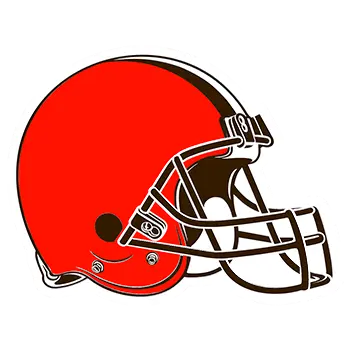
NFL Championships: 0 appearances
All-time W-L: 486-505-11 (49%)
The Cleveland Browns play at FirstEnergy Stadium in Cleveland, Ohio. Cleveland has not seen much success over the years. The Browns haven’t won a conference championship since before the NFL-AFL merger of 1970. Recent history hasn’t changed the team’s legacy much – the Browns haven’t made the playoffs in twelve years. In fact, Cleveland hasn’t won a playoff game since 1989, the longest standing drought in the league. Part of the reason for the Browns’ modern struggles has been poor player management and a lack of luck at the draft table. Cleveland hasn’t had a player enshrined in the Hall of Fame since Ozzie Newsome, who officially retired in 1990.
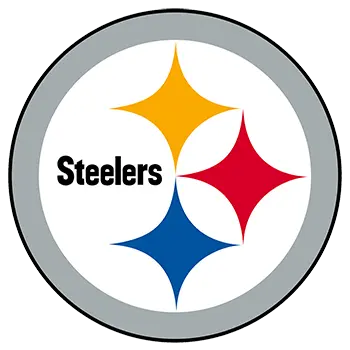
NFL Championships: 6 out of 8 appearances
All-time W-L: 643-556-21 (54%)
The Pittsburgh Steelers play at Heinz Field in Pittsburgh, Pennsylvania. Before the merger, the Steelers were the oldest team to never win a championship. Since 1970, the Steelers have been the most successful team on paper in the NFL. No team in the league has won more Super Bowl titles or hosted more conference championships than the Steelers. Pittsburgh has been the home of two legitimate NFL dynasties. Terry Bradshaw and an infamous defense produced 4 titles in the 70s, while Ben Roethlisberger and Hines Ward won two high-profile Super Bowl games in the early 2000s.
AFC South
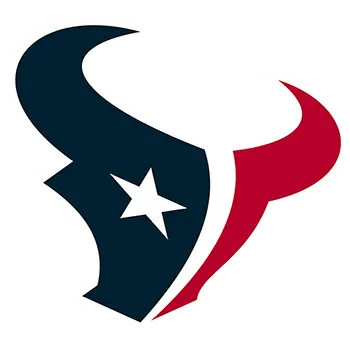
NFL Championships: 0 appearances
All-time W-L: 135-169-0 (44%)
The Houston Texans play at NRG Stadium in Houston, Texas. The Texans were added to the NFL in 2002, after the controversial relocation of the Oilers to Tennessee in 1996. Expansion has not been easy in Houston; the Texans have just two playoff appearances to their credit, and have the dubious honor of being the NFL franchise that’s taken the longest to win its first 100 games. The team’s best-known asset is JJ Watt, the defensive powerhouse considered by many to be the single most valuable player in the league.
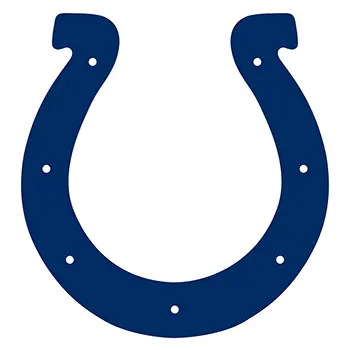
NFL Championships: 2 wins out of 7 appearances
All-time W-L: 534-473-7 (53%)
The Indianapolis Colts play at Lucas Oil Stadium in Indianapolis, Indiana. The Colts are an original NFL franchise, having switched over to the AFC as part of the NFL-AFL merger negotiations in 1970. Originally located in Baltimore, the team was moved to Indianapolis literally overnight, much to the chagrin of local fans, who supported the team for the better part of three decades. The Colts are a modern league success story, having appeared in the playoffs every season but one since 2002.
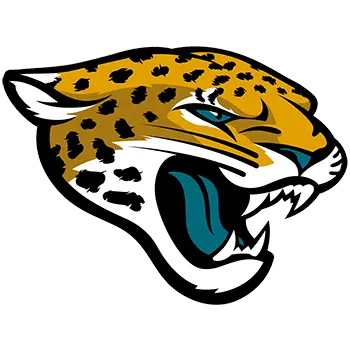
NFL Championships: 0 appearances
All-time W-L: 177-239 (42%)
The Jacksonville Jaguars play at EverBank Field in Jacksonville, Florida. Added to the league in 1995, as part of an expansion that included the addition of the Carolina Panthers, Jacksonville is a small-market team that’s met with limited success. The Jaguars have appeared in the playoffs just seven times since their inception, with no conference championships or Super Bowl titles to their credit. EverBank Field is currently home to the world’s largest digital scoreboards.
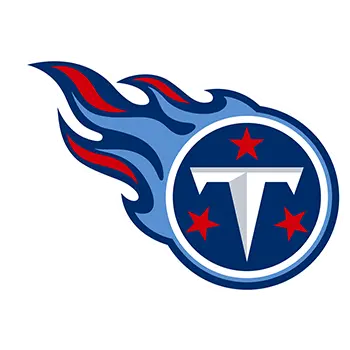
NFL Championships: 0 wins out of 1 appearance
All-time W-L: 451-475-6 (49%)
The Tennessee Titans play at Nissan Stadium in Nashville, Tennessee. The team moved to Tennessee from Houston in 1997, switching names from the Oilers to the Titans. Though the Oilers had some solid success in the league during their time in Houston, the Tennessee branch of the team’s history has won just one conference championship, in 1999. That year, the first that the team was called the Titans, they got to the Super Bowl through a wild card berth. The team was largely made up of former Houston Oilers players. Tennessee hasn’t made a playoff appearance since 2008.
AFC West
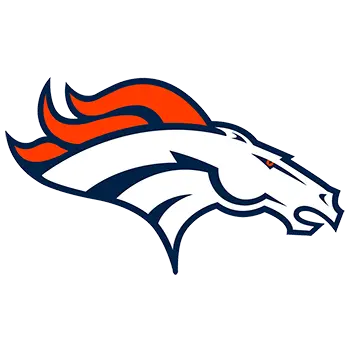
NFL Championships: 2 wins out of 7 appearances
All-time W-L: 488-434-10 (53%)
The Denver Broncos play at Sports Authority Field in Denver, Colorado. The story of the Broncos is fascinating because the team was so unsuccessful in its early years. The Broncos didn’t record a winning record in its first thirteen seasons. Since 1979, the Broncos have recorded just six losing records, winning seven conference titles and two Super Bowl championships along the way. John Elway, roundly considered one of the greatest football players of all time, played his entire career in Denver. The team has continued its QB-driven success, signing Peyton Manning away from the Colts in 2012.
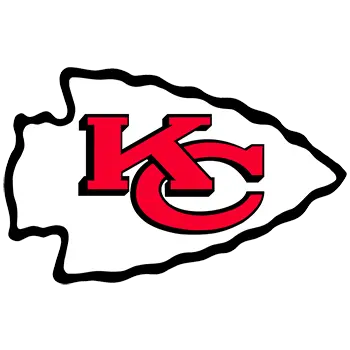
NFL Championships: 1 win out of 1 appearance
All-time W-L: 481-423-12 (53%)
The Kansas City Chiefs play at Arrowhead Stadium in Kansas City, Missouri. Though the Chiefs were a charter member of the American Football League, and have been a part of the NFL since the 1970 merger, the team has yet to win a conference championship or appear in a Super Bowl since that year. The Chiefs were an up-and-coming squad in the early 1990s, perennial playoff contenders, but failed to capitalize on the success of Marty Schottenheimer beyond the divisional round. This all changed in 2025 when Patrick Mahomes happened.
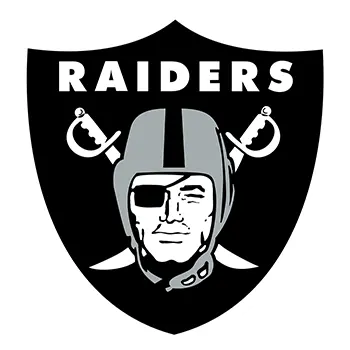
NFL Championships: 3 wins out of 4 appearances
All-time W-L: 481-440-11 (52%)
The Las Vegas Raider will now play their games at Allegiant in Las Vegas. The Raiders joined the American Football League before the merger that created the modern NFL. In the leagues’ first two decades, the Raiders were a powerhouse, winning the Super Bowl three times in the span of seven seasons. Since moving to (and returning from) Los Angeles, the Raiders haven’t been able to replicate their early success, winning just four playoff games in the past twenty-five years. Hopefully their luck changes with another city change.
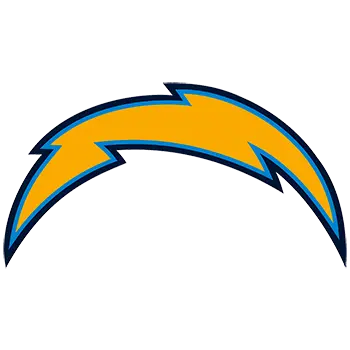
NFL Championships: 0 wins out of 1 appearance
All-time W-L: 459-462-11 (52%)
Formerly based in San Diego since 1961, the Chargers moved to Los Angeles in 2017 and operate out of the SoFi Stadium at Hollywood Park. The Bolts are not known for producing elite seasons in terms of wins or titles, but the franchise has always been good for exciting offensive production. Philip Rivers and Dan Fouts give the Chargers two Hall of Fame caliber passers, while franchise-leading rusher LaDainian Tomlinson gave the Bolts one of the most dynamic running backs the league has ever seen.
The National Football Conference (NFC)
The NFC is the AFC’s counterpart, also created as part of the NFL-AFL merger of 1970. The NFC is considered the conference of parity – only one NFC team (the Detroit Lions) has never appeared in the Super Bowl. Only one NFC team (the Seattle Seahawks) has made back-to-back Super Bowl appearances since the league realignment in 2002. Here’s a guide to each team in the National Football Conference, broken up by division.
NFC East
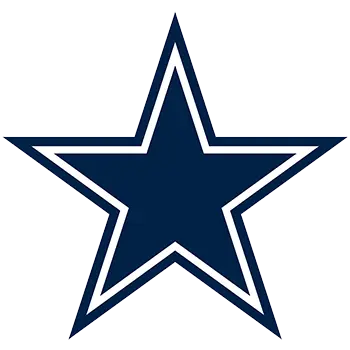
NFL Championships: 5 wins out of 10 appearances
All-time W-L: 526-398-6 (57%)
The Dallas Cowboys play at AT&T Stadium in Arlington, Texas. “America’s Team” is a controversial one, for a number of reasons. The Cowboys have the highest regular-season winning percentage in modern league history. They’ve won five Super Bowls, and have appeared in the second-most title games overall. Dallas is the home of fifteen Hall of Fame players, with 22 division titles to their credit. But along with success on the field has come trouble off it – today’s Dallas Cowboys team is rife with discipline problems, peripatetic roster shuffling, and an overactive rumor mill. Dallas experienced two legitimate NFL dynasties in the 1970s and 1990s.
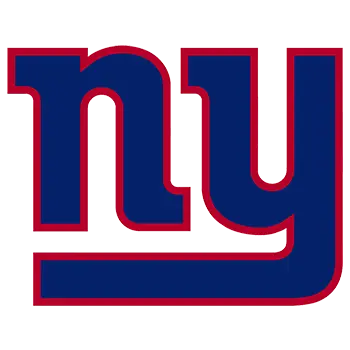
NFL Championships: 4 wins out of 5 appearances
All-time W-L: 702-618-33 (53%)
The New York Giants play at MetLife Stadium in East Rutherford, New Jersey. New York joined the league in 1925, and are the only of those five original franchises to still be active. The Giants have appeared in more total championship games than any other franchise, going back to the pre-merger days. The Giants’ rivalry with the Philadelphia Eagles goes back to 1933, and is considered the best in the modern NFL. The team’s seven playoff appearances since 2000 represents a major turnaround in fortune from the dark days of the 1990s.
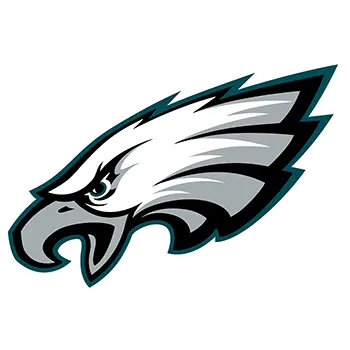
NFL Championships: 1 wins out of 3 appearances
All-time W-L: 590-619-27 (49%)
The Philadelphia Eagles play at Lincoln Financial Field in Philadelphia, Pennsylvania. Though the Eagles were perennial playoff contenders throughout the 2000s, they have not been a historically-successful team. Between 1962 and 1975, Philadelphia registered just one winning season. The arrival of Ron Jaworksi brought the city its first taste of NFL success, with four consecutive playoff appearances to start the 1980s.

NFL Championships: 3 wins out of 5 appearances
All-time W-L: 610-612-28 (50%)
The Washington Football Team play at FedEx Field in Landover, Maryland. The Washington Football Team have been marred in recent years by controversy over their mascot name and overall poor performances on the field – the team has won just one playoff game since 1999. It’s difficult to watch the team struggling considering their history as a true power in the NFL. Between 1982 and 1991, Washington appeared in the postseason seven times, winning four conference championships along the way, along with three Super Bowls.
NFC North
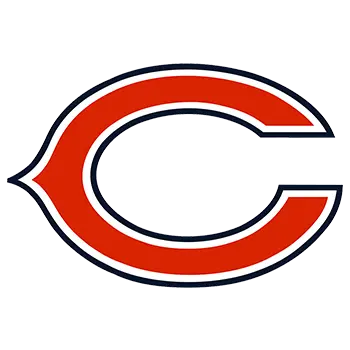
NFL Championships: 1 win out of 2 appearances
All-time W-L: 777-599-42 (56%)
The Chicago Bears play at Soldier Field in Chicago, Illinois. Chicago is another of the NFL’s storied franchises, founded in 1919 before the first professional leagues even existed. The Bears hold the record for most players enshrined in the Hall of Fame and most retired jerseys. Despite all that buzz, the Bears have won the NFL’s Super Bowl just once, in 1985, under Mike Ditka. The team has won the conference just once since that time, in 2006, behind a powerful defense and the flash-in-the-pan talent of QB Rex Grossman.
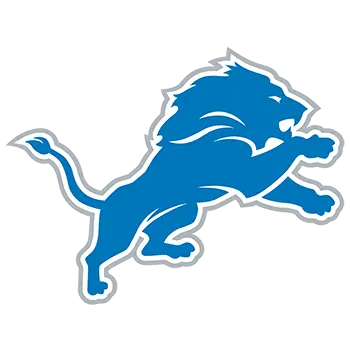
NFL Championships: 0 appearances
All-time W-L: 567-681-33 (46%)
The Detroit Lions play at Ford Field in Detroit, Michigan. The Lions won four championships before the 1970 merger, but have yet to appear in a Super Bowl game since that time. The Lions are the only NFC team to never appear in the league’s championship game. Detroit has struggled to reach the playoffs, doing so just eleven times since 1970. The Lions haven’t won a playoff game since 1993, and turned in an 0-16 record in 2008.
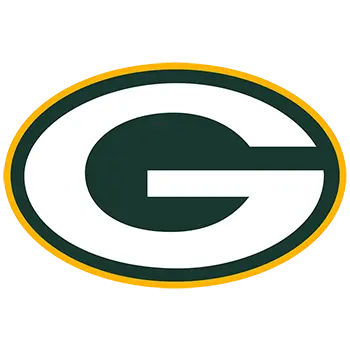
NFL Championships: 2 wins out of 3 appearances
All-time W-L: 769-577-38 (57%)
The Green Bay Packers play at Lambeau Field in Green Bay, Wisconsin. The Packers were organized in 1919 before the advent of professional football, and are the oldest team in the league that still operates from its original location. Green Bay is the only non-profit community-owned major sports team in the United States, and it appears that structure has worked well for them. The Packers are among the most successful teams in the league, with seventeen division credits, multiple conference titles, and two Super Bowls on the shelf.
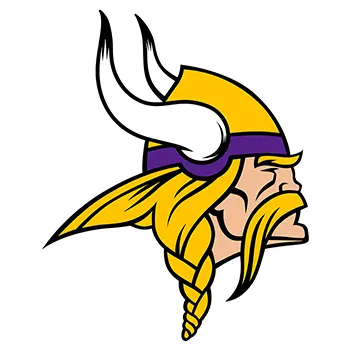
NFL Championships: 0 wins out of 3 appearances
All-time W-L: 495-412-11 (54%)
The Minnesota Vikings play at TCF Bank Stadium in Minneapolis, Minnesota. Considered the most successful team to have never won a Super Bowl, Minnesota was the first expansion team in the NFL. The team has won three conference titles, eighteen division titles, and has been a perennial playoff contender since 1988. Fun fact: Vikings QB Brad Johnson is the only NFL player to throw a TD to himself, doing so in 1997 after catching his own deflected pass and running it in for six points.
NFC South
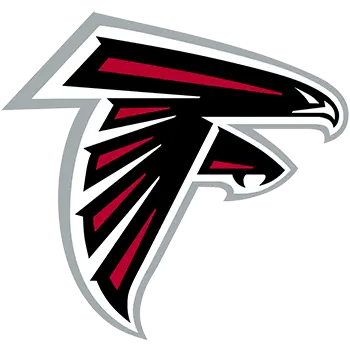
NFL Championships: 0 wins out of 1 appearance
All-time W-L: 369-473-6 (44%)
The Atlanta Falcons play at the Georgia Dome in Atlanta, Georgia, but will soon move to the brand-new Mercedes-Benz Stadium being built across the street. The Falcons are a difficult team to break down, because their limited success has come in fits and spurts. Atlanta has never claimed back-to-back division or conference titles. Under QB Matt Ryan, the Falcons have become a respectable opponent again, reaching the playoffs four times, for a playoff record of 2-2.
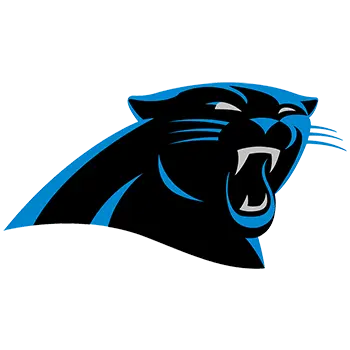
NFL Championships: 0 wins out of 1 appearance
All-time W-L: 200-215-1 (48%)
The Carolina Panthers play at Bank of America Stadium in Charlotte, North Carolina. Though the Panthers finished 7-9 in their first season as an expansion team, it would be a decade before Carolina won more games than it lost. The 2003 edition of the Panthers, nicknamed the Cardiac Cats for their many close wins, went 11-5 under QB Jake Delhomme and very nearly beat the New England Patriots in Super Bowl XXXVIII, if not for a heroic kick by the Pats’ Adam Vinatieri. The acquisition of young QB Cam Newton has put the Panthers in the spotlight again, with two consecutive playoff appearances and an undefeated start to the 2015 season.
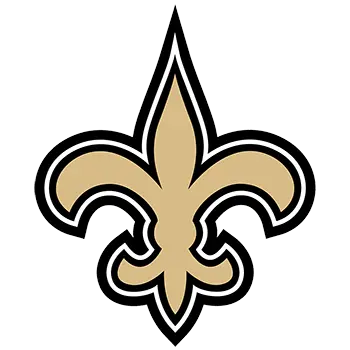
NFL Championships: 1 win out of 1 appearance
All-time W-L: 387-442-5 (47%)
The New Orleans Saints play at Mercedes-Benz Superdome in New Orleans, Louisiana. The Saints were easily the NFL’s worst team for the first three decades of their existence, failing to win a playoff game until the year 2000. The 2009 Saints are by far the highlight of the team’s history, winning 13 games and bringing the Super Bowl trophy back home to Louisiana for the first (and so far only) time ever.
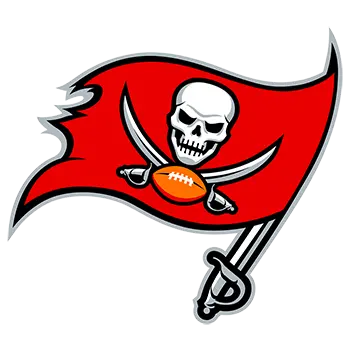
NFL Championships: 2 wins out of 2 appearances
All-time W-L: 278-429-1 (39%)
The Tampa Bay Buccaneers play at Raymond James Stadium in Tampa Bay, Florida. The Buccaneers have the unlucky title of “least successful NFL team in history,” thanks to a winning percentage that’s hovered around 38% for the better part of a decade. After a brief winning stretch during the late 70s and early 80s, the Buccaneers had 14 losing seasons in a row. Their 2002 Super Bowl win came after a decade’s struggle for relevancy, and the team has never recovered from the aftermath of that victory. Tampa Bay is currently in the middle of an eight season playoff drought but they’re hoping that Tom Brady can turn that around.
NFC West
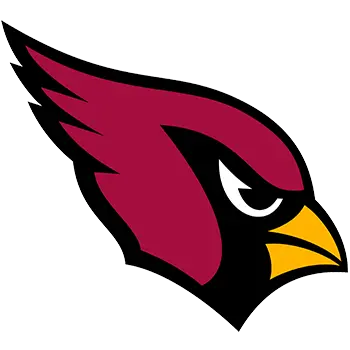
NFL Championships: 0 wins out of 1 appearance
All-time W-L: 566-771-41 (43%)
The Arizona Cardinals play at University of Phoenix Stadium in Glendale, Arizona. The Cardinals have been an organized football club since the late 19th century, long before professional football was even a consideration. The Cardinals have among the lowest winning percentage in NFL history – with just one conference championship and a handful of divisional titles to their credit. The Cardinals are the oldest pro football team to have never won a league championship.

NFL Championships: 1 win out of 3 appearances
All-time W-L: 587-575-21 (50%)
The Los Angeles Rams returned home in 2017, following an over 20-year stay in St. Louis, Missouri. The franchise’s time outside of L.A. has proven to be their most successful, as famed stars such as Kurt Warner, Marshall Faulk and Torry Holt led the team to two Super Bowl appearances and their lone championship. Now operating in the SoFi Stadium at Hollywood Park, the Rams push forward with a youth movement led by Jared Goff and head coach, Sean McVay.
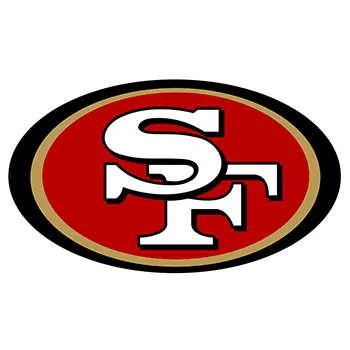
NFL Championships: 5 wins out of 7 appearances
All-time W-L: 551-485-14 (53%)
The San Francisco 49ers play at Levi’s Stadium in Santa Clara, California. A charter member of the old AAFC league, the team has been in professional contention for seven decades. The 49ers won four Super Bowls in the 80s and another in the 90s on the backs of QBs Joe Montana and Steve Young. Though the team recently snapped a decade-long playoff drought, San Francisco has never been as good as those teams in the 1980s.
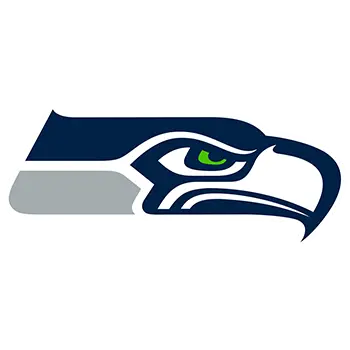
NFL Championships: 1 win out of 3 appearances
All-time W-L: 367-340-1 (52%)
The Seattle Seahawks play at CenturyLink Field in Seattle, Washington. The Seahawks once had a reputation as a losing team. Expansion is tough, and while some Seattle teams in the 70s and 80s had limited success, the team struggled mightily during the late 80s and the entire decade of the 1990s. Between 1988 and 2003, Seattle turned in just one winning record. Two distinct Seahawks teams have worked to change the impression of Seattle as a cupcake – the Shaun Alexander and Matt Hasselbeck-led 2005 squad, the first Seattle team to win a conference championship, and the 2013 Super Bowl champions, led by Russel Wilson.
Famous NFL Coaches
The NFL is a league driven by strong personalities. At different times in the league’s history, which now spans three centuries, coaches have played larger and smaller public roles. An argument could be made that the modern game is focused far more on players than coaches, though we have our infamous coach personalities of our own.
For this section, we wanted to pick five coaches that represented a number of different NFL eras, but also coaches who deserve mention. The coaches below knew how to win, and spent time creating teams that won multiple championships, be they in the NFL, the AFL, the NFC, or the AFC. These coaches had longevity, a presence in the Hall of Fame, and are remembered as much for their personality as for what they did for professional football.
Tom Landry
Besides inventing two of the most popular forms of defense used to this day, the Flex and the 4-3, Landry coached the Dallas Cowboys to an astounding 20 straight winning seasons between 1966 and 1985. Though Landry’s team won just two Super Bowls, the Cowboys were a near-constant presence in the league’s title game, earning 6 total conference championships under Landry’s tutelage. Tom Landry is remembered for his hat, his winning ways, and for creating the juggernaut that is now known as “America’s Team.”
Bill Belichick
This is going to be a controversial pick. For starters, Belichick seems to lack the one thing that all the other names on this list have – a strong personality. Belichick is a behind-the-scenes guy, a man willing to bend the rules in order to win. How has it profited him? In just two decades, his Patriots have won the Super Bowl three times and generally made a fool of their opponents. The Patriots show no signs of slowing down, having claimed seven of the last nine AFC East divisional titles. Belichick’s trademark windbreaker and scowl are far more memorable than anything he’s ever said in a press conference.
Paul Brown
Paul Brown earned his spot on this list in a little-known period of NFL history. As a head coach between the years of 1946 and 1955, he led Cleveland to 10 straight championship games in two different pro leagues, all while managing players who constantly screamed for more money and threatened to vacate if they didn’t get their wish. Paul Brown is the reason we have the facemask, the concept of playbooks, the draw play, long-standing coaching contracts, and the use of the 40-yard dash during recruiting. Brown is also an outstanding coach because of the coaching talent he produced – Don Shula, Lou Saban, Chuck Noll, and Bill Walsh all studied under Brown.
Vince Lombardi
If you need any more evidence as to why Lombardi belongs on this list than the fact that his name is on the Super Bowl trophy, I don’t know what to tell you. Let’s start with his coaching bona fides – Lombardi’s head coaching career with the Green Bay Packers lasted just nine seasons, from 1959 – 1967. But during those nine years, his team played in the NFL Championship game six times, winning five championship titles along the way. After Lombardi lost the league title in 1960, he never lost another playoff game, finishing with a postseason record of 9-1. Vince Lombardi was a beloved coach and leader, and his name will forever be a part of NFL history.
Don Shula
Don Shula is the greatest pure coaching talent the league has ever seen. He was a head coach for 32 years, recording just two losing seasons during that time. No coach has won more games than Shula, who recorded a 68% overall winning percentage during the 30+ years he coached. He performed the head coach role in the Super Bowl six times, a record only recently matched by Bill Belichick. His Dolphins recorded the league’s only perfect season. Don Shula’s influence is still being felt, by virtue of the spread of coaches he taught and mentored around the league. As the first modern defensive genius, the only man to hold an opposing team to 3 points or less in a league championship, Shula will be remembered as long as pro football is played in America.
Classic NFL Games
We’ve selected four classic games for this section – not because they’re our favorite games or because they’re traditional selections, but because we think they represent the best the NFL has to offer in terms of single-game entertainment. Any one of these games would be instantly recognized as a classic by any fan of the sport.
Super Bowl LI
 Atlanta Falcons
28
Atlanta Falcons
28
 New England Patriots
31
New England Patriots
31
February 5, 2017
It never feels fair to point to a game in recent memory as being one of the best ever, but few will deny that Super Bowl 51 between the New England Patriots and Atlanta Falcons delivered on the hype. Tom Brady and co. were favored to win, but due to turnovers and a high-powered Atlanta offense, looked dead in the water after a horrifying start. That put the Patriots into a 28-3 hole that looked insurmountable considering no Super Bowl comeback over 10 points had ever been accomplished before. Brady had some magic left in the end, however, as the Patriots capitalized on poor game management and turnovers from Atlanta to crawl back into the game and force overtime. Once in the league’s first-ever Super Bowl OT, Brady marched the offense right down the field, with a short James White score capping the incredible comeback and handing New England their fifth world title.
Super Bowl XLIX
 New England Patriots
28
New England Patriots
28
 Seattle Seahawks
24
Seattle Seahawks
24
February 1, 2015
Don’t accuse me of recency bias for declaring Super Bowl 49 one of the greatest NFL games ever played. This truly was an epic contest. Consider the facts: these were by far the best two teams in the league. They had an identical (amazing) record. New England had the number-one scoring differential in the league, while Seattle had the second-best. Seattle was the defending champ, but New England was playing with a chip on its shoulder, trying to avoid the end of the Brady-Belichick era. It was an epic set-up for a football game, and the game itself was equally epic. The final two minutes of the first half produced three touchdowns. Then New England engineered a fourth quarter comeback against one of the league’s top defenses of all time. Controversy over Seattle’s decision to throw the ball at the goal-line – a decision that led directly to the Seahawks’ losing the game – has made this the greatest Super Bowl of all time, and one that fans will argue about for decades.
The Hail Mary Game
 Dallas Cowboys
17
Dallas Cowboys
17
 Minnesota Vikings
14
Minnesota Vikings
14
December 28th, 1975
Have you ever thrown a “Hail Mary” pass? If so, then you should be familiar with this game. Trailing 14-10 with just under two minutes remaining, the Cowboys made an insane nine play drive up to midfield. With just 24 seconds left on the clock, QB Roger Staubach launched a ball to the end-zone. The receiver, Nate Pearson, pushed the Vikings’ cornerback Nate Wright to the ground and caught the pass. No flag was thrown on the play, no penalty was called, and the Vikings crowd went nuts. Even so, the Cowboys were declared winners. Afterwards, Roger Staubach said that he said a quick prayer after launching the pass, and the Hail Mary was born.
The Tuck Rule Game
 New England Patriots
13
New England Patriots
13
 Oakland Raiders
16
Oakland Raiders
16
January 19, 2002
This game isn’t necessarily an example of an amazing NFL contest – rather an example of how one play can affect the rules for the entire league. Especially when that one play involves the NFL’s darling QB Tom Brady. This game took place in one of the worst snowstorms in recent memory, and the Raiders and Patriots duked it out for defensive dominance for four solid quarters, without either team able to take charge of the game. Late in the game, with Oakland up 13-10, Tom Brady dropped back to pass. What happened next changed the game forever. Brady says he saw the rush and attempted to tuck the ball and accept a sack. Instead, he dropped the ball, and it was ruled a fumble. Upon review, officials determined Brady’s arm was moving forward, declaring the play an incomplete pass. Possession didn’t change hands, and the Patriots prevailed. The rules have since been changed to allow QBs even greater freedom to tuck and move the ball in the pocket.
The Greatest Game Every Played
 Baltimore Colts
23
Baltimore Colts
23
 New York Giants
17
New York Giants
17
December 28, 1958
Not only was this roundly considered the greatest game ever played for thirty years, it was also the first nationally-televised football contest. This game represented the league championship of 1958. This was an epic battle between two powerhouses of the league, starring Johnny Unitas at QB for the Colts. At halftime, Baltimore was up 14-3, which at the time was considered a sizable lead. During the second half, the Giants rallied to a 17-14 lead, despite two costly fumbles that could have put the game out of reach for Baltimore. Then Johnny Unitas got his hands on the ball with two minutes left to play, and executed a perfect two-minute drill, tying the game at 17. The tired Giants offense quickly turned the ball over, giving Unitas the opportunity he needed to seal the deal with a 23-17 victory.
From the NFL Record Books
Here are some interesting records from the NFL record books.
- George Blanda played in the NFL for 26 seasons between 1949 and 1975. He retired at the age of 48, also holding the record for most points scored by a single player and most extra points kicked.
- LaDainian Tomlinson holds the record for most points scored in a regular season – he was personally responsible for 186 points for the Chargers in the year 2006. That same year, he set the record for most touchdowns in a single season, with 31. In 2011, kicker David Akers set the record for most points scored without a single touchdown, kicking for 166 total points for the 49ers.
- Matt Prater holds the record for longest field goal. The 64-yard bomb he kicked against Tennessee in December of 2013 was just one yard longer than the previous record-holder.
- Aaron Rodgers currently holds the record for highest QB rating in a career, registering a 106.5 rating over the eleven years he’s been playing. He also holds the record for highest single-season QB rating, turning in a 122.5 for the 2011 season. Rodgers is also an efficient passer – he is the current record-holder for most consecutive pass attempts without an INT.
- Brett Favre has the dubious honor of being the QB who was sacked the most times. During his career, from 1991-2010, Favre was put on his back 525 times. At the other end of the spectrum, Steve Walsh, who was sacked only three times in his entire ten-year career.
- Antonio Cromartie holds the current record for longest single play for his 109-yard blocked field goal return in November, 2007. This play bested the previous record by thirteen yards, and seems unlikely to ever be overturned.
Super Bowl Champions
The Super Bowl is the NFL championship game, played each year between the two teams left standing after the league’s postseason. The Super Bowl is the sports event of the year in the United States – advertising is never more expensive than during the TV broadcast of the Super Bowl.
To date, 55 Super Bowl games have been played, one per year dating back to 1967. We’ve included a list of each Super Bowl champion for easy reference.
| I | Green Bay Packers | II | Green Bay Packers |
| III | New York Jets | IV | Kansas City Chiefs |
| V | Baltimore Colts | VI | Dallas Cowboys |
| VII | Miami Dolphins | VIII | Miami Dolphins |
| IX | Pittsburgh Steelers | X | Pittsburgh Steelers |
| XI | Oakland Raiders | XII | Dallas Cowboys |
| XIII | Pittsburgh Steelers | XIV | Pittsburgh Steelers |
| XV | Oakland Raiders | XVI | San Francisco 49ers |
| XVII | Washington Redskins | XVIII | LA Raiders |
| XIX | San Francisco 49ers | XX | Chicago Bears |
| XXI | New York Giants | XXII | Washington Redskins |
| XXIII | San Francisco 49ers | XXIV | San Francisco 49ers |
| XXV | New York Giants | XXVI | Washington Redskins |
| XXVII | Dallas Cowboys | XXVIII | Green Bay Packers |
| XXIX | San Francisco 49ers | XXX | Dallas Cowboys |
| XXXI | Green Bay Packers | XXXII | Denver Broncos |
| XXXIII | Denver Broncos | XXXIV | St.Louis Rams |
| XXXV | Baltimore Ravens | XXXVI | New England Patriots |
| XXXVII | Tampa Bay Buccaneers | XXXVIII | New England Patriots |
| XXXIX | New England Patriots | XL | Pittsburgh Steelers |
| XLI | Indianapolis Colts | XLII | New York Giants |
| XLIII | Pittsburgh Steelers | XLIV | New Orleans Saints |
| XLV | Green Bay Packers | XLVI | New York Giants |
| XLVII | Baltimore Ravens | XLVIII | Seattle Seahawks |
| XLIX | New England Patriots | 50 | Denver Broncos |
| LI | New England Patriots | LII | Philadelphia Eagles |
| LIII | New England Patriots | LIV | Kansas City Chiefs |
| LV | Tampa Bay Buccaneers | LVI | TBD |
Interesting Facts About the NFL
- The Green Bay Packers’ ticket waiting list is 1,000 years long. Every seat in the stadium is reserved for a season ticket holder, and only about 100 people per year give up their seats to a new owner.
- A single cowhide makes ten professional footballs. The sixteen laces on the ball are laced with a single thread.
- The 2000 Super Bowl champion Baltimore Ravens had a five-game stretch in which they didn’t score a touchdown and their only points were field goals by Matt Stover (14 in all).
- The Vince Lombardi Super Bowl trophy costs the league just $25,000, or about one-fourth of one league minimum salary.
- In 1988, no quarterbacks were taken in either the first or second round of the NFL draft, the only time in the history of the draft that a QB wasn’t taken at some point in the first round, much less the second.
- The total audience for the first televised NFL game? 500 people … a far cry from the half a billion people who watched the big game last year.
- Joe Theismann changed the pronunciation of his name in college so it would rhyme with Heisman, hoping it would help him win the award. He didn’t, but he would go on to be the NFL’s MVP, twice.
- Of the eleven games since 1987 that involve point spreads of 20 or more, the favorite has only covered two times.
- When no administrators or owners could agree on an alignment plan of the NFC after the AFL/NFL merger, Pete Rozelle’s secretary put the five plans in a vase and selected one at random. We still use this alignment to this day.
- The NFL and the Chicago Bears were incorporated and named on the same day, June 24, 1922.
- Sammy Baugh once led the NFL in punting, passing, and interceptions all in the same season.
Betting on The NFL
Betting on the NFL is big business. Millions of dollars are wagered on games every weekend during the regular season, and the Super Bowl is one of the single biggest betting events in world sports. Many people who bet on the NFL do so purely recreationally, because they enjoy backing their favorite teams or just find that having money riding on games makes watching them more exciting.
Others take their NFL betting much more seriously, closely studying the form and delving into the stats to determine where the best opportunities for profit lie. And there is merit to this approach, as it’s possible to make very good money if you know what you’re doing. If this sounds appealing to you, you should take a look at our football betting guide.
Football Betting Guide
Our football betting guide is a useful resource for anyone with an interest in betting on the NFL, or the NCAA for that matter. It covers all the basics you need to know to get started, and features a wealth of strategy advice that will help you to find profitable betting opportunities.









